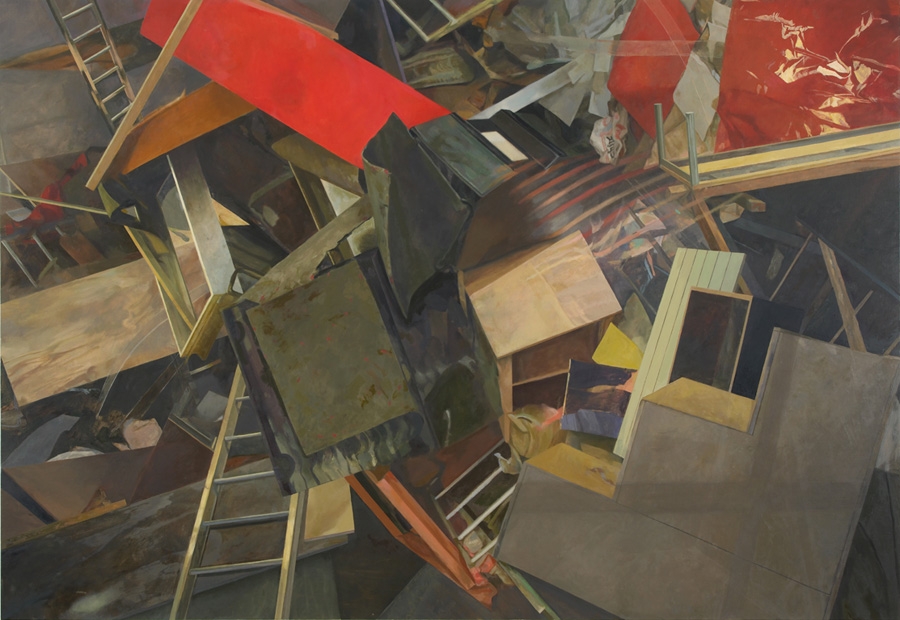For over 40 years, Stuart Brisley’s interrogation of a tense, iniquitous world has generated forceful and compelling images, most memorably recorded in the photographs taken during his physically demanding performances from the 1970s. While his work in a range of media never claims a rapport with its audience, Brisley’s countercultural outlook has consistently aimed at a deeper, democratic convergence with spectators’ attitudes in elusive moments of shared identity. These two exhibitions, which close with a performance by the artist structured to unfold at intervals during the final week, mark his eightieth birthday and are split between the London galleries that jointly represent him.
They serve usefully to sum up the aspects of his work that make Brisley important and to anticipate significant events elsewhere, notably a retrospective later this year at Modern Art Oxford. Additionally, in November 2013 Brisley’s Poly Wheel – a tall circular construction of 212 metal stacking chairs instigated by the artist and built by workers during their breaks at the Hille furniture factory in Suffolk, where the artist had been invited to undertake a fellowship in 1970 – was recreated at the Merz Foundation in Turin.
Poly Wheel was symbolic of the convergence between Brisley and those drawn into his methods, whether as spectators or, in this case, the furniture-makers. Working through communication and collaboration, the wheel emerged as much through exchange as through making. Although Hille adopted the self- supporting structure as a corporate mascot, the process of its creation brought to the surface familiar divisions in industry at the time between shopfloor and management. Indeed, the antagonism of employment, class and political structures is a recurrent theme that Brisley crystallises into image and action.
Documented at Mummery + Schnelle is 12 Days, the 1975 performance in Rottweil, Germany, in which Brisley constructed a wooden cage and crammed himself inside. Monochrome prints show Brisley performing in private (to build the cage) and in public (to burst out of it). Since no spectator can reasonably witness the entirety of these protracted rituals, his collaborators’ photographs and films serve as testimony, distilling long durations into summarised sequences of images, and extend the piece out of real time into a vibrant archive that is no less Brisley’s work than the original event.
The three large Interregnum canvases (2011–13) at Mummery + Schnelle modify that temporal relationship and were made from photographs of Next Door (The Missing Subject), Brisley’s performance-cum-installation at Peer, London, in May 2010. On that occasion, which coincided with the days of political horse-trading that followed Britain’s inconclusive general election, the artist occupied the vacant shop next door to the venue, piling together the furniture and equipment abandoned by the previous occupiers, three failed businesses.
The topical allusion to the teetering institutions of the British state, manifested in the paintings’ tour of the dishevelled heap he assembled, survives with the viewer sensing that the precarious pictorial mass could tumble into actual space. Reconfigured provocatively into a hybrid of genres reminiscent of Delacroix and Géricault, the images spark a contemporary discussion in terms influenced by classic revolutionary painting.
Although most associated with the body as his primary medium, Brisley began as a painter and made sculpture abroad in the 1960s. Returning to Britain imbued with the spirit of dematerialisation, he developed his first performances following installations, and all these activities (to which photography and writing should be added) continue. While Brisley is a more multifaceted artist than many expect, his sensibility is strikingly painterly. The stuff of painting – from paint itself or its substitute (with which he often smears himself in performances), to gesture, narrative and image-making – has been a persistent element in his work over decades.
The four large watercolour and gouache landscape paintings at Domobaal demonstrate a particular affection for paint media and their transfigurative properties. Collectively titled Jerusalem (2010–11), they adopt different view- points – from above, from up close and at a distance – on scenes of apparent wilderness and neglect. Yet the tangle of undergrowth and traces of ancient labour actually depict nature at its healthiest, recycling its energies into new growth. Brisley takes on misconceptions common among urban populations whose knowledge of landscape is mostly derived from aestheticised media representations and heritage sites rather than from exposure to natural processes. Brisley again phrases his observation in the pictorial language of historical genre, namely the English land- scape tradition associated with the aristocratic hegemony over the land and its use.
By citing Milton (1810), Blake’s radical poem, Brisley underlines this misapprehension. For Blake, too, has been traduced: his warning against the forces moulding minds into orthodoxy, when set (just over 100 years after the poem’s publication) to Hubert Parry’s stirring melody for Jerusalem (1916), has been abducted by the British status quo in the form of a popular ‘patriotic’ hymn. True to form, Brisley holds a mirror to society for us to recognise the outmoded systems constraining our autonomy as citizens.
This article first appeared in the January & February 2014 issue.
